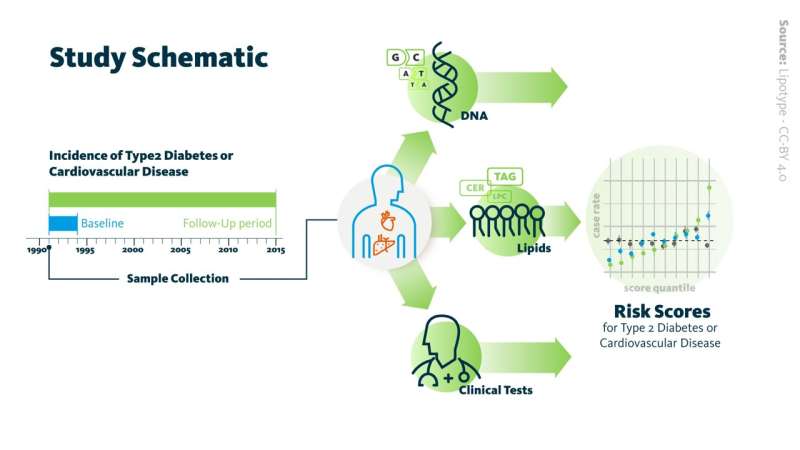Lipid profiling can predict risk of diabetes, cardiovascular disease decades before onset

Simultaneous measurement of dozens of types of fats in the blood ("lipidomics") can predict the risk of developing type 2 diabetes (T2D) and cardiovascular disease (CVD) years in the future, according to a new study publishing March 3rd in the open-access journal PLOS Biology from Chris Lauber of Lipotype, Germany, and colleagues. Such early prediction through lipidomic profiling may provide the basis for recommending diet and lifestyle interventions before disease develops.
Current assessment of risk for T2D and CVD relies largely on patient history and current risk behaviors, and the levels and ratio of two major blood lipids, high- and low-density cholesterol. But the blood contains over one hundred other types of lipids, which are thought to reflect at least in part aspects of metabolism and homeostasis throughout the body.
To assess whether a more comprehensive measure of blood lipids could increase the accuracy of risk prediction, the authors drew on data and blood samples from a longitudinal health study of over 4,000 healthy, middle-aged Swedish residents, first assessed from 1991 to 1994, and followed until 2015. Using baseline blood samples, the concentrations of 184 lipids were assessed with high-throughput, quantitative mass spectrometry. During the follow-up period, 13.8% of participants developed T2D, and 22% developed CVD.
To develop the lipid-based risk profile, the authors performed repeated training/test rounds on the data, using a randomly chosen two-thirds of lipid data to create a risk model, and then seeing if the model accurately predicts risk in the remaining third. Once the model was developed, individuals were clustered into one of six subgroups based on their lipidomics profile.
Compared to the group averages, the risk for T2D in the highest-risk group was 37%, an increase in risk of 168%. The risk for CVD in the highest-risk group was 40.5%, an increase in risk of 84%. Significant reductions in risk compared to the averages were also seen in the lowest-risk groups. The increased risk for either disease was independent of known genetic risk factors, and independent of the number of years until disease onset.
There are several potentially important implications of these findings. On an individual level, it may be possible to define risk decades before disease onset, possibly in time to take steps to avert disease. Lipidomics, either in combination with genetics and patient history or independent of them, may provide new insights into when and why disease begins. In addition, by identifying those lipids that contribute most to risk, it may be possible to identify new drug candidates.
"The lipidomic risk, which is derived from only one single mass-spectrometric measurement that is cheap and fast, could extend traditional risk assessment based on clinical assay," Lauber said. In addition, individual lipids in blood may be the consequences of or contribute to a wide variety of metabolic processes, which may be individually significant as markers of those processes. If that is true, Lauber said, "the lipidome may provide insights much beyond diabetes and cardiovascular disease risk."
Lauber adds, "Strengthening disease prevention is a global joint effort with many facets. We show how lipidomics can expand our toolkit for early detection of individuals at high risk of developing diabetes and cardiovascular diseases."
More information: Lauber C, Gerl MJ, Klose C, Ottosson F, Melander O, Simons K (2022) Lipidomic risk scores are independent of polygenic risk scores and can predict incidence of diabetes and cardiovascular disease in a large population cohort. PLoS Biol 20(3): e3001561. doi.org/10.1371/journal.pbio.3001561




















